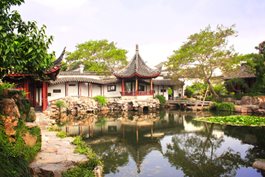
"To build a house, to plant trees, and flowers and to grow vegetables - this is the plain man's politics; the administration of a humble man."
This popular Chinese saying is thought to be the inspiration for the "Humble Administrator's Garden," which, like all of Suzhou's spectacular urban oases, is a horticultural interpretation of an idealized utopian retreat: a world away from the machinations and intrigues of the Chinese imperial bureaucracy.
Suzhou's gardens represent the zenith of centuries of garden design in China, which brings together diverse principles of philosophy, sculpture, painting, architecture, drama, calligraphy, and poetry into an earthly interpretation of an ideal universe or a heavenly paradise, designed for a solitary person or small group of like-minded friends for meditation, contemplation, and prayer.
The famous gardens of Suzhou were already a highlight of the prosperous silk manufacturing center in 1276 when Marco Polo first visited and dubbed the city, "the Venice of the East," not only because of the city's network of canals and waterways, but also because, like Venice, Suzhou was an important center of trade and learning, popular with rich merchants, scholars, and physicians, as well as the gifted architects, artists, and artisans who made Suzhou the architectural gem it remains today.
Suzhou then owed its considerable prosperity to its strategic location on the Yangzi river and the all-important Chinese silk monopoly. Reaching the peak of its power and influence under the Ming Dynasty (1368-1644), Suzhou was always a popular retreat for retired politicians and administrators, many of whom commissioned the exquisite gardens, which numbered over 200 before the 1800s, of which some 90 remain today.
The gardens of Suzhou are fashioned from water and rocks, using the natural landscape and existing landmarks as their orientation and inspiration. The gardens are constructed using principles of classical Chinese garden design such as "a borrowed view from afar," in which the limited space is enhanced by focusing on a distant landmark. Other techniques include the careful juxtaposition of near and far, vertical and horizontal, and clear reality contrasted with the diffused reflections in water. All of these age-old techniques render the gardens of Suzhou that which they were always meant to be: earthly paradises.
Experience the true spirit of China's traditional culture on one of Alexander + Roberts’s carefully designed itineraries such as our
China Sampler.